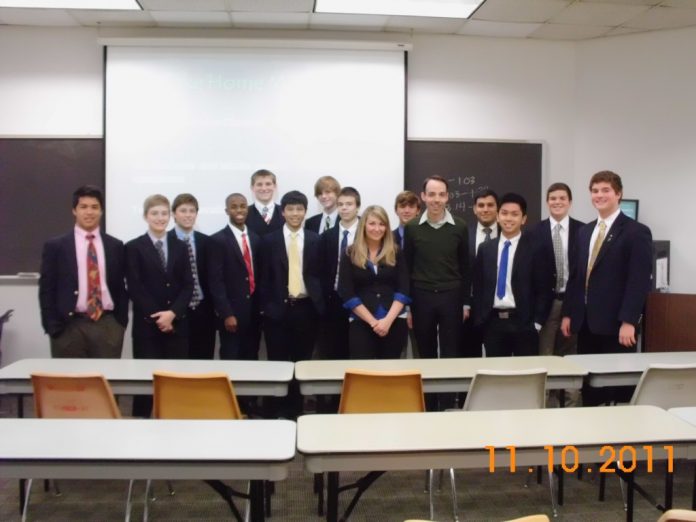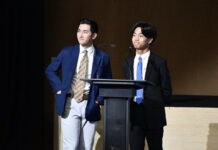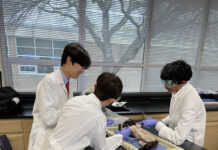This past Friday, November 11, 2011, Jesuit students in the Medical Society ventured to University of Texas Southwestern on an all-day field trip to learn more about medicine and the medical field. Biology teacher Jan Jones, the head of the medical society, has been taking students on this field trip for years.
Mrs. Jones, physics teacher Max Von Schlehenried, two juniors, nine sophomores, and one freshman all piled into the small yellow school bus around 9 AM to begin their day. The ride there was full of suspense, with students discussing the fun they had on previous field trips.
When we arrived, we watched a fifteen minute video on suturing, the act of sewing a patient’s wounds. From there we were given the necessary tools to sew someone up: a needle, three pairs of unique scissors, forceps, and a stretched rubber glove to act as skin.
We began our first attempts at sewing, which were much harder than the video made it look if I do say so myself. “It’s an exact art,” agreed Daniel Sanders ’14. Alexander Curry ’14 added: “I have always been interested in medicine, and as a lifeguard, I have wanted to learn somewhat more advanced treatment techniques. Now that I know how to suture I will be able to practice with the sutures my dad brings home from work!”
After this we moved on to Physical Therapy with Amy Elliston, where we were able to see how casts are made, which is a surprisingly simple process. A rigid material is put into hot water where it becomes flimsy, and from there it can be molded and then hardened into a shape that is desirable.
Last, we saw some of the tests that patients would go through to improve their hand-eye coordination and reaction times. This was a new experience for many of us who had preconceived notions about physical therapy, including Killian Womack ’14 who said, “When I thought of the physical therapy room, I thought of physical rehabilitation. But at the hospital, they treat many different types of cases such as burn victims or people who have mental trauma from car accidents, not just physical rehabilitation.”
In our last lecture, which was about depression. Dr. Shawn McClintock and Tabatha Melton enthusiastically lectured on this serious subject. To start off the lecture they established a baseline: depression is a disease not a choice. They went on to say that most people will go through depression at one point in their lives.
Depression can cause different side effects, depending on age, making this an unusual disease to diagnose. Some people sleep for 20 hours straight, others for maybe 3 hours a day. Many entertainers have suffered from depression at some point in their lives, including Ann Hathaway, Ben Stiller, Jim Carrey, Ricky Williams, and Terry Bradshaw. Bradshaw, one of the best quarterbacks of all time, had cried after winning games because he was in such discontent with himself. Fortunately, this disease does not have to stop people from being themselves again. There are drugs, therapy, and helpful people, as the lecturers noted.
This lecture was supposed to last roughly an hour and a half, but the students were so interested that it lasted two hours. “I not only enjoyed the lecture on depression,” said Paul Le, ’14. “I loved it. I learned multiple new and interesting things on depression that most people would not expect, and everyone really got to engage in questions and discussions about depression.”
He wasn’t the only one to enjoy the lecture though, as Jason Nguyen ’14 explained: “I really enjoyed the talk on depression. It was the most interesting discussion not only because I was shocked to learn that depression is an actual disease, but also because it was something that I could relate to my own life. The speakers really connected this topic to my personal life, which made me even
more curious and excited about the subject.”
Overall, the students really seemed to take a lot away from this lecture and this field trip as a whole. Mrs. Jones agreed, adding that her favorite part of the trip was “watching the students to see how involved they were in the program and listening to the intelligent questions that they asked.” She went on to say that she and Mr. Von Schlehenreid were “very proud of [their] students.”






